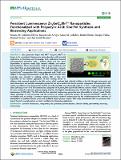Por favor, use este identificador para citar o enlazar a este item:
http://hdl.handle.net/10261/349204COMPARTIR / EXPORTAR:
 SHARE SHARE
 CORE
BASE CORE
BASE
|
|
| Visualizar otros formatos: MARC | Dublin Core | RDF | ORE | MODS | METS | DIDL | DATACITE | |

| Título: | Persistent Luminescence Zn2GeO4:Mn2+ Nanoparticles Functionalized with Polyacrylic Acid: One-Pot Synthesis and Biosensing Applications |
Autor: | Calderón-Olvera, Roxana M.; Arroyo, Encarnación; Jankelow, Aaron M.; Bashir, Rashid; Valera, Enrique CSIC ORCID; Ocaña, Manuel CSIC ORCID; Becerro, Ana Isabel CSIC ORCID | Palabras clave: | Biosensing Colloidal stability Functionalization Immunoassay Nanoparticles Persistent luminescence Photostability Zinc germanate |
Fecha de publicación: | 3-may-2023 | Editor: | American Chemical Society | Citación: | ACS Applied Materials and Interfaces 15(17): 20613–20624 (2023) | Resumen: | Zinc germanate doped with Mn2+ (Zn2GeO4:Mn2+) is known to be a persistent luminescence green phosphor with potential applications in biosensing and bioimaging. Such applications demand nanoparticulated phosphors with a uniform shape and size, good dispersibility in aqueous media, high chemical stability, and surface-functionalization. These characteristics could be major bottlenecks and hence limit their practical applications. This work describes a one-pot, microwave-assisted hydrothermal method to synthesize highly uniform Zn2GeO4:Mn2+ nanoparticles (NPs) using polyacrylic acid (PAA) as an additive. A thorough characterization of the NPs showed that the PAA molecules were essential to realizing uniform NPs as they were responsible for the ordered aggregation of their building blocks. In addition, PAA remained attached to the NPs surface, which conferred high colloidal stability to the NPs through electrostatic and steric interactions, and provided carboxylate groups that can act as anchor sites for the eventual conjugation of biomolecules to the surface. In addition, it was demonstrated that the as-synthesized NPs were chemically stable for, at least, 1 week in phosphate buffer saline (pH range = 6.0-7.4). The luminescence properties of Zn2GeO4 NPs doped with different contents of Mn2+ (0.25-3.00 mol %) were evaluated to find the optimum doping level for the highest photoluminescence (2.50% Mn) and the longest persistent luminescence (0.50% Mn). The NPs with the best persistent luminescence properties were photostable for at least 1 week. Finally, taking advantage of such properties and the presence of surface carboxylate groups, the Zn2GeO4:0.50%Mn2+ sample was successfully used to develop a persistent luminescence-based sandwich immunoassay for the autofluorescence-free detection of interleukin-6 in undiluted human serum and undiluted human plasma samples. This study demonstrates that our persistent Mn-doped Zn2GeO4 nanophosphors are ideal candidates for biosensing applications. | Versión del editor: | https://doi.org/10.1021/acsami.2c21735 | URI: | http://hdl.handle.net/10261/349204 | DOI: | 10.1021/acsami.2c21735 | ISSN: | 1944-8244 | E-ISSN: | 1944-8252 |
| Aparece en las colecciones: | (ICMS) Artículos |
Ficheros en este ítem:
| Fichero | Descripción | Tamaño | Formato | |
|---|---|---|---|---|
| calderón-olvera-et-al-2023-persistent-luminescence-zn2geo4-mn2-nanoparticles-functionalized-with-polyacrylic-acid-one.pdf | 5,68 MB | Adobe PDF |  Visualizar/Abrir |
CORE Recommender
SCOPUSTM
Citations
8
checked on 28-abr-2024
Page view(s)
14
checked on 01-may-2024
Download(s)
1
checked on 01-may-2024
Google ScholarTM
Check
Altmetric
Altmetric
Este item está licenciado bajo una Licencia Creative Commons

